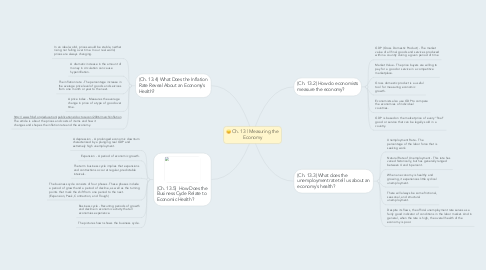Ch. 13 | Measuring the Economy
von JACKSON VIGESAA

1. (Ch. 13.2) How do economists measure the economy?
1.1. GDP (Gross Domestic Product) - The market value of all final goods and services produced within a country during a given period of time
1.2. Market Value - The price buyers are willing to pay for a good or service in a competitive marketplace.
1.3. Gross domestic product is a useful tool for measuring economic growth.
1.4. Economists also use GDP to compare the economies of individual countries.
1.5. GDP is based on the market price of every “final” good or service that can be legally sold in a country.
2. (Ch. 13.3) What does the unemployment rate tell us about an economy's health?
2.1. Unemployment Rate - The percentage of the labor force that is seeking work.
2.2. Natural Rate of Unemployment - This rate has varied historically, but has generally ranged between 4 and 6 percent.
2.3. When an economy is healthy and growing, it experiences little cyclical unemployment.
2.4. There will always be some frictional, seasonal, and structural unemployment.
2.5. Despite its flaws, the official unemployment rate serves as a fairly good indicator of conditions in the labor market. And in general, when the rate is high, the overall health of the economy is poor.
3. (Ch. 13.4) What Does the Inflation Rate Reveal About an Economy’s Health?
3.1. In an ideal world, prices would be stable, neither rising nor falling over time. In our real world, prices are always changing.
3.2. A dramatic increase in the amount of money in circulation can cause hyperinflation.
3.3. The inflation rate - The percentage increase in the average price level of goods and services from one month or year to the next.
3.4. A price index - Measures the average change in price of a type of good over time.
3.5. http://www.frbsf.org/education/publications/doctor-econ/2006/march/inflation The article is about the prices and costs of items and how it changes and shapes the inflation rate and the economy.
4. (Ch. 13.5) How Does the Business Cycle Relate to Economic Health?
4.1. A depression - A prolonged economic downturn characterized by a plunging real GDP and extremely high unemployment.
4.2. Expansion - A period of economic growth.
4.3. The term business cycle implies that expansions and contractions occur at regular, predictable intervals.
4.4. The business cycle consists of four phases. These phases include a period of growth and a period of decline, as well as the turning points that mark the shift from one period to the next. (Expansion, Peak, Contraction, and Trough)
4.5. Business cycle - Recurring periods of growth and decline in economic activity that all economies experience.
4.6. The picture shown shows the business cycle.


